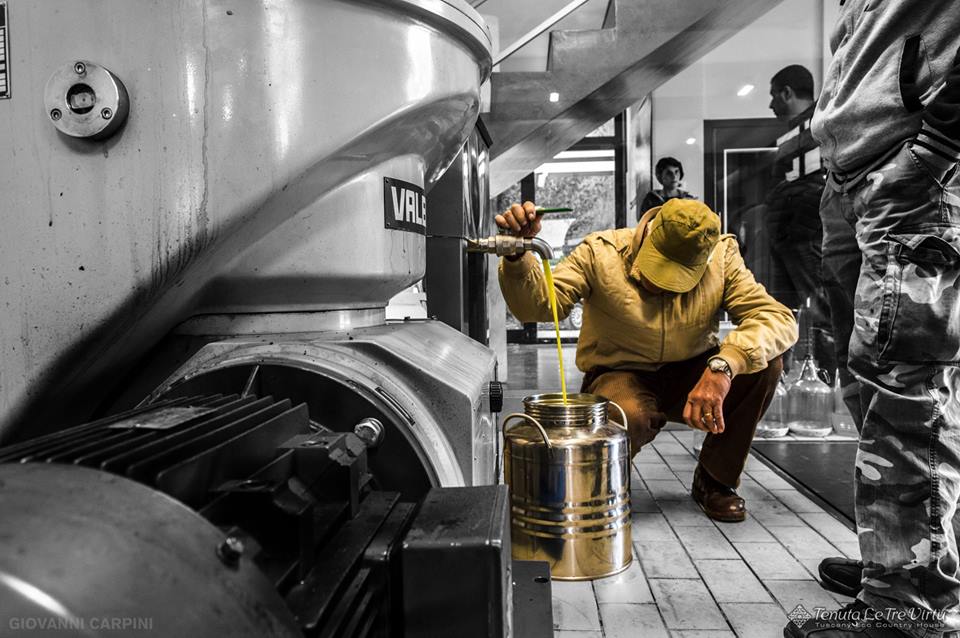Green Gold: Tuscan Olive Oil Harvest
Green Gold: Tuscan Olive Oil Harvest

In the hills surrounding Florence, olive oil has been made for centuries. During the late fall, the olives reach maturation and are harvested by hand. The fruity, rich golden green color and low acidity (0.2-0.5)—characteristic of most Tuscan olive oils—is the result of the four main varieties grown in Tuscany: frantoio, moraiolo, leccino and pendolino.
HARVEST
In November, a perfect mixture of green and ripe olives are stripped away with glove hands or combs onto nets or parachutes that are spread around the olive trees. The olives are stored in crates until they can be taken to the olive press where the perfect drops of oil, present in healthy olives, are separated from the fruit and water.
There has been a growing interest in excellent quality olive oil and hence great advances have been made in extraction methods. We miss the atmosphere of the traditional stone wheel- hydraulic press mills, but the new enclosed, continuous feed systems of modern mills have greatly diminished the characteristic oxidation and fermentation and the result is a higher quality of oil of intense aroma and a longer shelf life.
The fact that extra virgin olive oil (EVOO) is made from the fruit of the plant (all other oils, except avocado, are made from the seeds) explains the complexity and diversity of its organoleptic properties: taste, color and aroma, which vary depending on the specific geographic area and variety of olive. It also accounts for its high nutritional value. Olive oil is primarily composed of monounsaturated fat. It contains no cholesterol and is rich in antioxidants such as vitamin E, carotenoids and phenolic compounds. The intensity of flavor and the nutritional value gradually diminish as an oil ages, but the rapidity of this process depends on the quality of the olives, the care with which the oll is made and how it is stored. And excellent quality extra virgin olive oil will mellow, but maintain its fruitiness for a year or so. For this reason, it should always have a harvest date on the bottle. By law, to be labeled “Extra Virgin Olive Oil” it must:
-Be extracted by a mechanical pressing of olives without resorting to the high heat and chemical solvents used for most other oils.
-Must have less than 0.8% acidic level.
-Pass and organoleptic (tasting) panel test with a score of 6.5 or more which means that it is devoid of defects.
MERITS
Freshness: the sensation of freshly squeezed fruit is primarily sensed by smell.
Spiciness: a slight spiciness which is present in the first few months after crushing. This sensation which you taste throughout your mouth disappears in a short time after swallowing. Its presence is a sure indication of the integrity and health of the fruit.
Fruitiness: The total of the natural aromas which remain intense and stable for at least a year after crushing.
Bitterness: a bitter sensation which is felt on the back palate can be present in the first months after crushing. This is a typical taste from green or slightly ripe olives with a high amount of polyphenols and which can be more or less pleasing depending on the intensity.
Harmony: When the fragrance, taste and tactile sensation are in perfect equilibrium.

DEFECTS
Rancidity: an unpleasant sensation of over ripe melons or pumpkins resulting from the aging of the oil caused by light, heat or oxidation.
Moldiness: a dank taste which inhibits salivation and results from the poor conservation of the olives before milling.
Scalding: a taste if boiled or overcooked legumes. This also results from the poor conservation of the olives before milling as well as elevated temperature during extraction.
Sediment: an unclean taste due to the prolonged contact between the oil and the natural residue of the olives during the extraction process.
Fattiness: a soapy, tactile sensation produced from olives which have been attached by the olive fly.
Coarseness: the absence of harmony and general cleanliness resulting from the crushing of olives in different states of maturity and inadequate conservation.

For Tuscan cooks it is the quality of the basic ingredients that are essential in order to create tasty, refined dishes without elaborate preparation.
The fresh, new oil is best used as a finishing oil. Grilled vegetables, meat and fish without marinating beforehand and then drizzle the oil and freshly chopped herbs of your choice (garlic, parsley, rosemary) just before serving them.
It’s distinctive flavor will make a real difference also when poured on steamed vegetables, crosini and soups.
